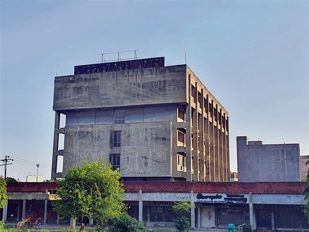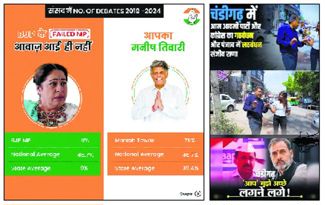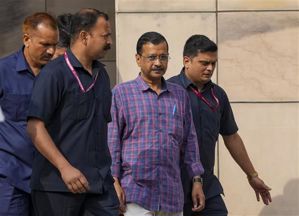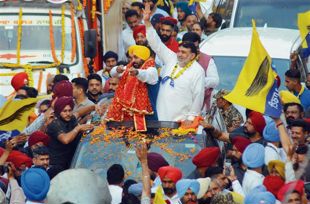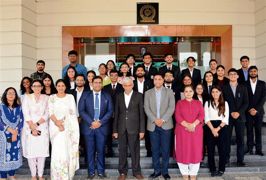
A portrait of a family in Jalandhar in the early 20th century. Though all women are wearing traditional Punjabi attire, kameez have cuffs and collars. They are also wearing western style shoes.
Jasvinder Kaur
During the entire British period, the traditional dress of women in Punjab did not undergo many changes. Their ensemble of salwar, kameez and dupatta — commonly called ‘suit’— saw little structural changes during this period. As men had a closer interaction with their European rulers, their dressing style was influenced by them. Women, on the other hand, practised purdah and therefore had limited interaction with the outside world. Due to this practice their dressing style, by and large, did not change much.

However, European influences did bring in some changes like the fusion of several western elements into women’s traditional clothes, the manner of tying a saree, and above all, the use of cosmetics and accessories. This is evident in old photographs of that period. At first glance, Punjabi women did look dressed in their traditional clothes. However, a closer look will reveal the presence of quite a few Western elements in many garments and accessories supplementing the basic Indian dress, mostly in upper-class women.
Borrowing from men’s clothes

In Europe, women’s dressing as well as their lifestyle had changed dramatically after World War I. Women had to lead more active lives, filling in the jobs that had once been the domain of men. This necessitated a new way of dressing that gave them the comfort and freedom to perform these new jobs with ease. Many women began wearing clothes similar to those worn by men.
In this post-war period, military influences were evident in the cut and colour of women’s garments. Jackets, waistcoats, ties, military collars, cuffs and boots became part of their wardrobes. According to newspapers of the era, it was difficult to make out the difference between men and women as they seemed to have similar silhouettes. Famous designer Coco Chanel, in the early part of her career in the 1920s, rode on this trend — as well as gave impetus to it. She started designing comfortable clothes for women that were inspired by menswear. One of her well-known outfits was based on the Englishman’s tweed suit.
Punjabi women’s clothes were also impacted by western styles as they also started adding collars and cuffs, found in men’s shirts, to their kameez/kurtas. Some district gazetteers mention women using European-style collars and cuffs on ordinary kurtas. Even the back of the kameez was now being styled like men’s shirt with a cross-back and a pleat below the collar. This style remained popular throughout Punjab till shortly after Independence. Even when its popularity waned, older women continued to wear this style for a long time.
However, this style has survived in Haryana (part of undivided Punjab) and Western UP. One can spot this trend in a recent Hindi film Saand Ki Aankh where Haryanvi women are seen wearing short shirts with men-style collars and cuffs. This style is also evident in old photographs and was replicated even in formal wear.
Vaskat or waistcoat
.jpg) A garment like the men’s waistcoat entered Punjabi women’s wardrobe around the end of 19th century. This was called the vaskat. The 1888-89 Gazetteer of Ludhiana district mentions that Jat women wore kurtas with a waistcoat as was worn by men. This was worn over their kurta or kameez with a dupatta draped over it. It became part of their formal attire worn at fairs and festive events. The word vaskat itself was a distortion of the word waistcoat, similar to English waistcoat.
A garment like the men’s waistcoat entered Punjabi women’s wardrobe around the end of 19th century. This was called the vaskat. The 1888-89 Gazetteer of Ludhiana district mentions that Jat women wore kurtas with a waistcoat as was worn by men. This was worn over their kurta or kameez with a dupatta draped over it. It became part of their formal attire worn at fairs and festive events. The word vaskat itself was a distortion of the word waistcoat, similar to English waistcoat.
.jpg)
The waistcoat had evolved in men’s dress by the early 20th century. The man behind evolution of its finer details was Prince Albert of Wales (later King Edward VII), who also brought changes in men’s fashion that are evident even today. Being a trendsetter, his wardrobe was copied all over the world. When Bertie (as he was known), went on vacation, tailors from all over Europe followed him, making notes and taking pictures. Edward decided to alter the waistcoat by lowering its height to reveal more shirt-front. Some say the change was done as the earlier version was more prone to food stains while some claim it was less constricting for the prince as he felt bloated during a meal and undid the bottom button of the waistcoat. This norm is followed till today.
Vaskat had many similarities to its parent garment — the waistcoat. The U-shaped neck, plain straight back, pointed lapels, use of European-style buttons — are all indicative of its origin. Some of these even had turned-over pockets like the men’s overcoats worn in England.
Cosmetics and accessories
The lifestyle changes that took place in Europe in the 1920s encouraged women to come out to work, as well as socialise. With the freedom to dress also came the freedom to use cosmetics, earlier associated with women of ill repute.

A container of Coty’s loose powder and (right) surme daani and surmchu. photos
by the writer
Cosmetics became popular in Europe. Lipstick, contained in a round, metal tube, had been invented in 1915. Commonly called ‘make-up’, cosmetics now became essential for a woman’s appearance. Hollywood movies of the 1920s and 1930s feature women carrying a distinctive look: red cupid-bow lips, dark rouge on the cheeks, kohl-rimmed eyes, plucked eyebrows, and wavy hair, generally with a shingle bob cut. They had typical mask-like appearance, achieved by using loose powder on the face.
During that time, hardly any women in rural Punjab used western cosmetics. These were neither available nor affordable. However, there were some traditional ingredients that could give similar results. Bark of Sakk tree (walnut tree) came in bags from the hills. Chewed upon for dental health and hygiene, it would also leave behind a bright orange lip stain, giving the appearance of lipstick. Women, both rural and urban, commonly used this more for cosmetic purposes than dental hygiene. There were surma and kajal for the eyes. Surma was available in rock form (galena stone) even in small village shops. Ground twice after soaking in gulab jal (rose water), it was then applied inside the eyelids with the help of a surmchu , a kind of a large, blunt needle, part of surme-daani (container in which surma was kept). Kajal was the soot gathered from the flame of the diya (wick-flame lamp). A drop of desi ghee or butter was used to moisten it and make it into paste/kajal. It was then applied on the outside of eyelids as well as on the eyelashes. Besides these, henna paste was used as a mask for hair, either for colour, tinting or as a conditioner.
As some stylish, upper-class women in Punjab, who followed European trends, took to using make-up, cosmetics started becoming available in bigger towns. Use of loose face powder became quite popular in early 20th-century Europe. Coty, a beauty products company, became popular and its loose powder was widely available in Punjab. It came in a round, small cardboard box with a ‘Made in England’ stamp at the back. Whether women used any other cosmetics or not, they did use the face powder and Coty’s face powder became a must for almost every urban woman. Other make-up products, as well as perfumes, became available in Punjab to a limited extent, and were advertised by shops in newspapers and magazines.
Many publications started publishing tips on how to use make-up. Sister Susie, in 1935, wrote about using mascara, lipstick, rouge and nail polish. Women at that time were not cosmetic conscious.
Along with make-up, wealthy women of Punjab also became aware of the latest hair grooming trends. Curling was as popular in Punjab as it was in Europe, and women used curling irons to create waves in their hair, a popular style in Europe of the 1920s and 1930s. This wavy style is evident in many photographs of the period, even if the women’s heads are covered, as was the norm in Punjab. There were shops in Lahore and Amritsar selling curling irons, and they often advertised them in magazines and newspapers like The Tribune.
Photographs of Punjabi women from the 1920s and 1930s show them wearing mostly Indian clothes, but with some western accessories. The most common and visible of these accessories was the brooch. The typical image of a woman from a well-to-do family has her with a covered head, wavy hair, and wearing a saree or a dupatta, held in place at the shoulder with a brooch.
After Independence, women’s dressing style changed as many of the above-mentioned styles faded away. However, as availability of things increased, more and more people started using cosmetics. It has become a huge multi-billion dollar industry.
Join Whatsapp Channel of The Tribune for latest updates.





















